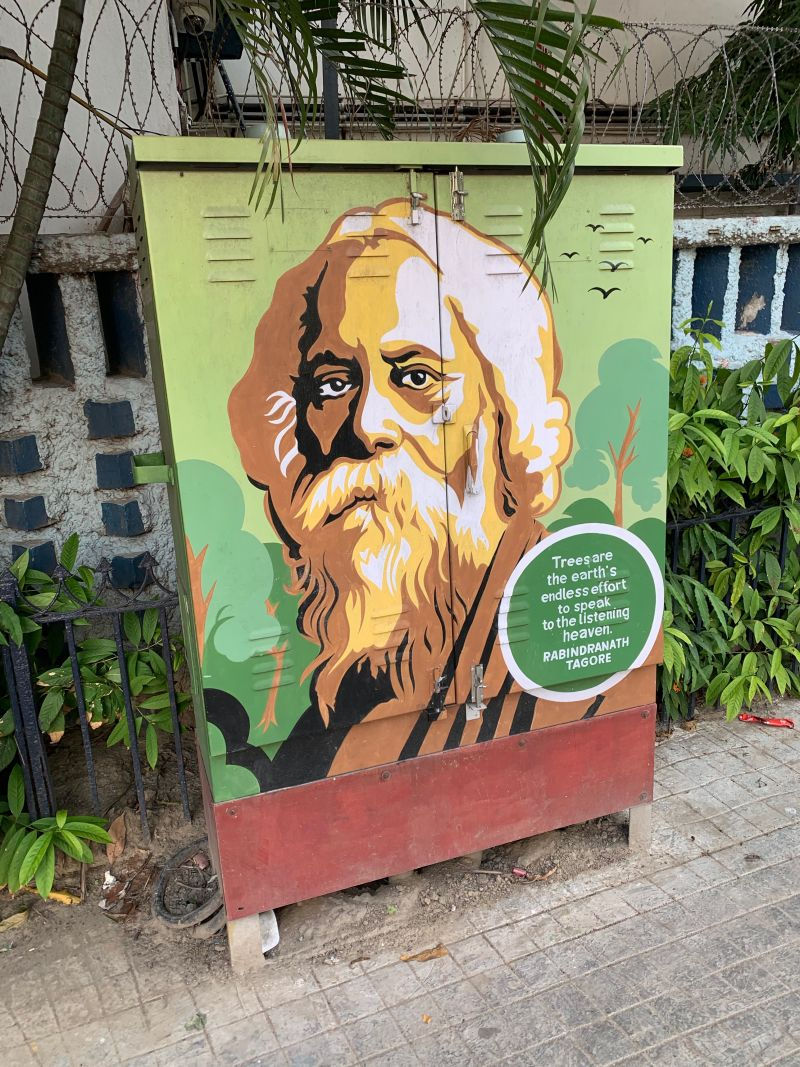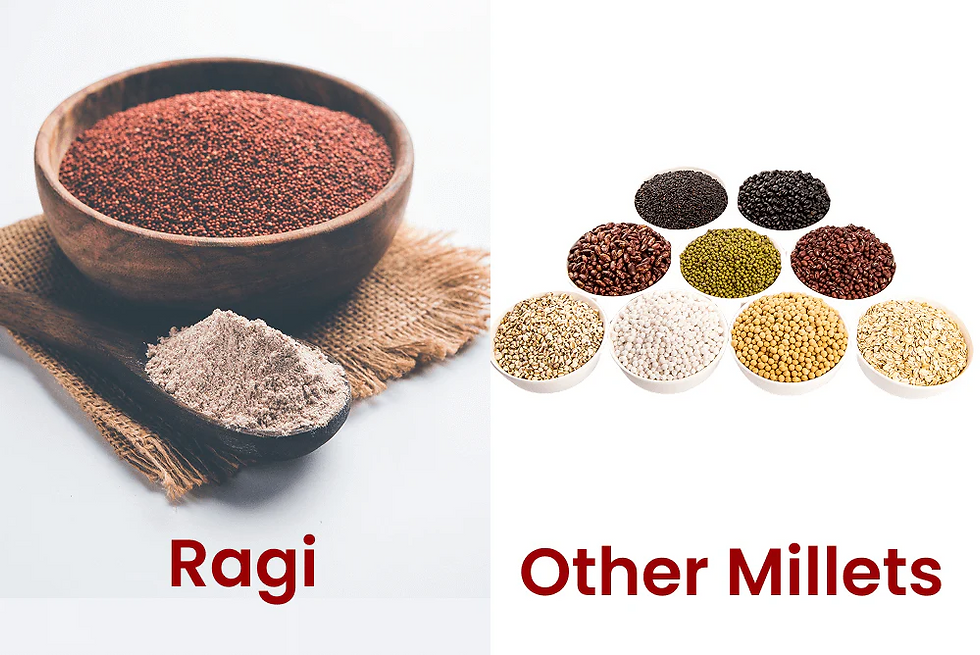Exploring Nature's Classroom: Tagore's Legacy and the Farm University
- Geetanjali Chakraborty

- Aug 4, 2019
- 4 min read
Updated: Apr 30, 2024
Every summer, I've made it a tradition to spend time in India with my family. It's a time for our children to bond with their grandparents and for all of us to reconnect with our cultural heritage. This year, we spent three weeks in Kolkata, and the evening strolls down its streets invoked strong memories of my childhood. The echoes of conch shells, the scent of incense wafting through the air, and the rhythmic beats of percussion instruments during evening rituals transported me back to my grandmother's Bengali traditions in our Delhi home. Reflecting through an Ayurvedic lens, I realized how these rituals engage our senses and encourage us to embrace our natural essence.

During one of our walks, I stumbled upon a poignant quote by India's Nobel laureate, Rabindranath Tagore, adorning a utility box:
"Trees are the earth's endless effort to speak to the listening heaven."
This encounter encapsulated the omnipresence of Tagore's spirit in Bengal, where nature is revered deeply in his literary works.
Visiting Nature's Classroom: Shantiniketan
Our family excursion also took us to Shantiniketan, the university town founded by Tagore with his Nobel prize funds. The institution, Vishwa Bharati, meaning Global India, continues to thrive, embodying Tagore's vision of inclusivity and unity across cultures. Tagore's belief in embracing all races and cultures resonates through his words, reflecting the essence of India as a unifying force:
"I do not think that it is the spirit of India to reject anything, reject any race, reject any culture. The spirit of India has always proclaimed the ideal of unity. The ideal of unity never rejects anything, any race, or any culture. It comprehends all, and it has been the highest aim of our spiritual exertion to be able to penetrate all things with one soul, to comprehend all things as they are, and not to keep out anything in the whole universe – to comprehend all things with sympathy and love. This is the spirit of India… India is there to unite all human races.” -- Tagore in his written Nobel acceptance speech
Named after Tagore's renowned poetry collection, 'Gitanjali,' Shantiniketan, meaning "abode of peace," exudes tranquility. Tagore's renaming of the Earleaf Acacia tree to "Shonajhuri," or gold shedder, reflects his intimate connection with nature, immortalized in his poems. The Shonajhuri grove, serving as the backdrop for the local market (haat), encapsulates Tagore's inspiration drawn from the environment. At the market, artisans showcase their craft amidst nature's serenity, accompanied by the soulful melodies of Baul musicians. The Bauls, fearless poets, urge us to break free from societal constraints and reconnect with our inner selves. Visiting Shantiniketan, one can't help but appreciate the profound influence of this environment on Tagore's artistic journey.

I was disheartened to discover that numerous Shonajhuri trees had been felled, coinciding with an unprecedented delay in the monsoon. During our visit, the microclimate, typically drenched in rain, remained remarkably dry. Locals attributed this drastic alteration to human-induced deforestation, highlighting the profound impact of our actions on the environment. It's a sobering realization of our collective responsibility.
Amidst this environmental concern, a hopeful sight greeted us at Vishwa Bharati: children engaging in a silent march, urging respect for nature during dignitary visits. Their placards, bearing the message "Please keep your surrounding environment beautiful," spoke volumes about their awareness and commitment to preserving the natural world.
The campus itself is a testament to this harmonious coexistence of art and nature. A popular attraction is the guided drive-through tour, where special trees take center stage. One such tree is the Chatim tree, where Tagore's father, Devendranath Tagore, found solace in meditation, weaving a profound connection between the landscape and the legacy of the Tagore family.

The Chatim tree holds a special significance at Vishwa Bharati, as its leaves are utilized to craft sataparni tokens, symbolizing the transition of graduating students. This tradition imbues a sense of reverence for nature, reinforcing the notion that we are mere guests in its vast domain.
Lessons from Our Farm University
Another sanctuary where I seek solace and knowledge is my parent's farm in Northern India. It resembles more of a farm university, concealing invaluable treasures of wisdom within its bounds. During my recent visit, I seized the opportunity to learn from the local villagers about the diverse array of plants inhabiting the land. Their insights unveiled profound secrets of nature.
Allow me to introduce our first botanical companion: Bhringraj, scientifically known as Eclipta Prostrata.

Bhringraj oil is renowned in India for promoting hair growth. During my exploration with the village elder, I witnessed a fascinating demonstration. Rubbing the Bhringraj leaf on one's hand releases a resilient greenish-black dye that requires considerable effort to remove. I later learned that this dye is popular for hair coloring in China, a revelation that resonated deeply with me. According to Ayurvedic scripture Bhavaprakash, Bhringraj is hailed as a tonic for hair and skin, adept at reducing excess kapha and vata doshas.
Now, let's delve into our second botanical ally: Bhoomi Amla, also known as Bhumyamlaki in Sanskrit (Botanical name: Phyllanthus Niruri). This plant is esteemed for its ability to pacify kapha and pitta doshas. Its taste profile encompasses bitterness, astringency, and sweetness. Villagers often chew the small ball-like structures on this plant, resembling amlaki, albeit smaller in size. This serves as a dietary supplement renowned for its liver-friendly properties. Recent studies have highlighted the efficacy of Bhoomi Amla syrup in treating viral infantile diarrhea and its churna formulation in alleviating diabetic neuropathy.

Our third botanical companion is Vasa, also known as Baash Pata in Bangla, Ataroosha in Sanskrit, and Adoosa or Adulsa in Hindi (Botanical name: Adhatoda Vasica). Since childhood, I've heard tales of Baash Pata from my father and late grandmother, revered as a remedy for coughs and colds. According to Bhavaprakash, Vasa not only soothes the voice but also mitigates kapha and pitta doshas. Its taste profile is characterized by bitterness and astringency. Remarkably, Vasa finds its place in cough syrups in both Ayurvedic and Unani (Greek) medicine traditions.

These plants often thrive wild and may be misconstrued as weeds by the untrained eye. During my exploration, I encountered at least thirteen different plant varieties flourishing on the farm and in the surrounding areas, all sharing a common trait: self-sustenance without human intervention. In our era, such invaluable knowledge runs the risk of fading into obscurity. My aspiration is to one day organize botanical walking tours that not only provide livelihoods for knowledgeable villagers but also ensure the preservation and transmission of this vital knowledge for future generations.





Comments